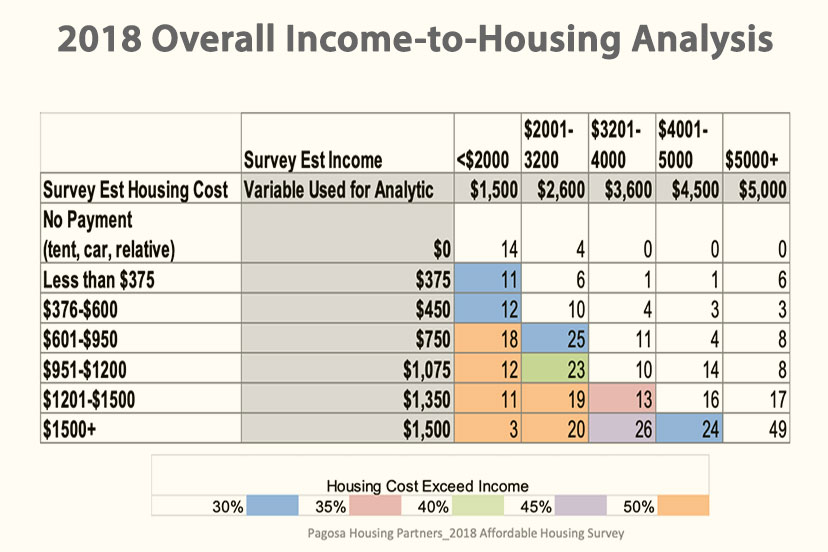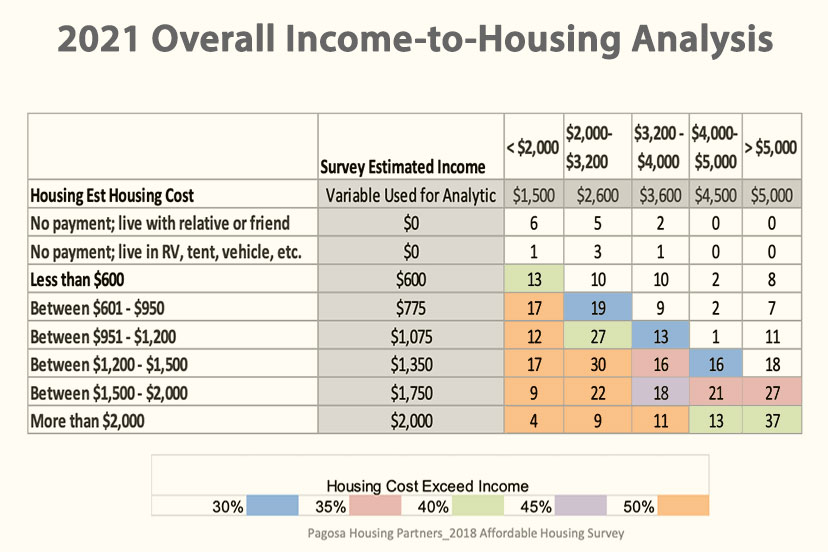We looked briefly, yesterday, at two charts developed by analyst Joanne Whitney from the responses to two community surveys conducted by Pagosa Housing Partners (PHP), one in 2018 and then again this past summer.
Before we look more closely at that PHP data, I’d like to share a bit of public comment provided to the Pagosa Springs Town Council, just prior to their vote last Thursday to approve the first reading of Ordinance 958. That ordinance, if passed on second reading, will severely limit the number of new vacation rental licenses permitted within the municipal limits.
Michelle Moore (not sure of the spelling) told the Council that she owns a vacation rental uptown near the Pagosa Lodge.
“I don’t think you’re addressing the issue, of people like us, where you buy a property… yes, we’re short-term renting it right now, because that is what we are using to help pay for our long-term vacation home as we get older. And there will be more people that need to short-term rental, to help pay for their home, so later in life they can come spend six or eight months here in Pagosa.”
Apparently, the term “short-term rental” has become a verb, among the younger investors who are now “short-term renting” homes that once served full-time residents here in Pagosa. The condos where Ms. Moore is “short-term renting” are not extravagant five-bedroom mansions. They were originally built as modest condos for middle-class families or couples, but are now being converted into mini-motels.
According to national vacation rental management company Vacasa, the people most likely to convert single-family homes into vacation rentals are between the ages of 20 and 50 — the generations often referred to as ‘Millennials’ and ‘Gen X’. The group most active in the vacation rental market, nationally, are aged 20 to 39 years, it seems. This suggests that many recently-purchased vacation rentals might remain cut off from our nation’s housing stock until at least 2050, as these young people finally approach retirement age.
Here is the breakdown of prospective vacation rental buyers, per Vacasa:
You can download the 2021 Vacasa report here.
Another Pagosa vacation rental owner, Snow White, offered this comment as part of her testimony:
“As a vacation rental owner myself, and like many of my fellow rental owners, we absolutely love Pagosa Springs. We spend our holidays, our vacations, many, many days there — and we want to see it thrive. And we also want to see solutions for workforce housing; we want to see the economy grow… and see new business emerge and pay their workers better than minimum wage…
“But it’s hard when you’re made to feel like villains of the town, and that’s how many of us feel. That we’re not welcome in Pagosa Springs, because we do rent out our homes at certain times throughout the year. It’s hard to feel like we’re part of the community…”
I doubt our Daily Post readers want anyone to feel unwelcome, in our community. Especially, perhaps, a person with an unusual name like ‘Snow White’ who absolutely loves Pagosa and spends many, many days here.
Unfortunately, the way the real estate market and rental market and vacation rental industry have developed over the past ten years, it’s not just certain vacation rental owners who feel unwelcome. Currently, many working individuals and families, who have made Pagosa their full-time residence, are feeling unwanted, unappreciated, and exploited. And in many cases, disheartened.
Here’s one of the charts from the 2018 Pagosa Housing Partners residential housing survey, shared yesterday in Part Two. PHP was here analyzing individuals and families who are paying in excess of 30% of their household incomes for housing — 30% being a standard measure used by Colorado Housing and Finance Authority, HUD, and other housing agencies to delineate ‘cost burdened’ families.
The families or individuals who are paying more than 50% of their household income on housing — the people who are ‘severely cost burdened’ — are shown in orange.
The PHP survey attempted to define respondents’ income according to commonly used housing income definitions, based on “Area Median Income” — the community’s “AMI”. Some housing programs qualify applicants according to 30% AMI, 60% AMI, 80% AMI or 100% AMI. PHP used those same approximate values, to sort the 2018 responses. What the chart above illustrates is that none of the surveyed Archuleta County households with incomes above $5000 a month — that is, above 100% of the Area Median Income — were ‘cost burdened.’
But in 2018, among low income households — workers earning less than 60% of AMI, which was by far the largest group of workers responding to the open survey — about 85% were cost burdened, and 37% were ‘severely cost burdened’, paying more than 50% of their household income for housing.
Even at the 80% AMI level, about 60% of households were ‘cost burdened’.
That was in 2018.
One of the goals of the 2021 PHP survey was to estimate changes in Pagosa’s housing situation, over the past three years. And one of the analytical charts that Ms. Whitney created for 2021 looked like this:
PHP was surprised (but perhaps not really surprised) to find that, even among the households earning in excess of 100% AMI — households that earn more than the average Pagosa Springs family — about 60% of the households responding to the survey were now ‘cost burdened’, with more than one-in-three of those families paying in excess of 40% of their income for housing.
The stats for the families earning between 30% and 80% AMI were much more dismal. Of the 204 working families that responded to the survey, and who earn less than 80% AMI, about nine out of ten families are ‘cost burdened’ — and about six out of ten families are ‘severely cost burdened’, paying more than 50% of their income on housing costs.
Families that, perhaps, are no longer feeling ‘welcome’ in Pagosa Springs?
Looking at the entire picture, it would appear, from this survey, that 79% of working families in Pagosa Springs — eight out of ten working families — are ‘cost burdened’ and 30% — three out of ten working families — are ‘severely cost burdened.’
But our tourists must feel welcome, because — according to the website AirDNA, they have plenty of vacation rentals to choose from in Archuleta County. About 1,170 active rentals, as of July.
At least someone feels welcome.




